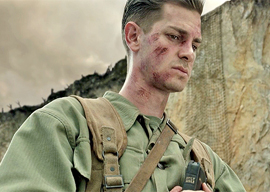
November 09, 2016

Andrew Garfield in Hacksaw Ridge
As Doss and his comrades clamber up the Navy cargo netting onto the Maeda Escarpment, better known as Hacksaw Ridge, the crucial high ground offering artillery observers a view of the intricate Japanese defenses of southern Okinawa, they encounter what one soldier called “all hell rolled into one.” Seizing this 200-foot-wide plateau that the Japanese had honeycombed with tunnels took a week and a half, with the Americans driven off the heights nine times. Most of the movie takes place in this claustrophobic kill zone.
As a combat movie, Hacksaw Ridge is visually most reminiscent of Paul Verhoeven’s 1997 science-fiction satire Starship Troopers. In Gibson’s dead-serious reworking of Verhoeven’s ludicrous fight scenes, the novice troops fail to spread out, bunching up in terrified huddles that are ripped apart by flying metal.
Gibson’s vision of combat is grotesque, almost hallucinatory. Gibson had starred in Randall Wallace’s 2002 Vietnam War movie We Were Soldiers, which featured blood squirting three feet in the air each time a soldier was shot. The carnage in Hacksaw Ridge, however, is much worse. Between the terror of what the metal storm does to human flesh and the protagonist not having a gun to fight back, the film drifts toward the horror genre.
Hacksaw Ridge is getting very good reviews, although I suspect some of that is due to unexpressed guilt over the mistreatment of an important artist due to ethnic animus.
Doss” low-church Protestantism isn”t an ideal fit for Gibson’s high-church Catholic aesthetics. And the musical score is corny. But if you go in without excessive expectations, Hacksaw Ridge is a solid comeback.
The battle of Hacksaw Ridge might have gone on all summer of 1945, but the pugnacious General Cho, disgusted by Colonel Yahara’s skepticism over whether the Japanese army could win, launched a massive offensive in hopes of landing a decisive blow.
Doss” battalion ran for their lives to get down the rope ladder. Doss, though, remained on the ridge, single-handedly retrieving at least fifty wounded men and lowering them down the 35-foot cliff.
Remarkably, that was just the beginning of Doss” real-life heroics, much of which had to be left out of the movie because audiences wouldn”t believe his self-sacrifice. From Doss” obituary in The New York Times, here’s a different battle that didn”t make the movie:
He cared for his injuries alone for five hours, rather than have another medic emerge from cover to help him. While he was finally being carried off on a litter, he spotted a soldier who seemed worse off. He leaped off the litter, directing his aid men to help the other soldier. Soon after that, Japanese fire hit him, and he suffered a compound arm fracture. He bound a rifle stock to his shattered arm as a splint, evidently the closest he ever came to handling a weapon, and crawled 300 yards to an aid station.